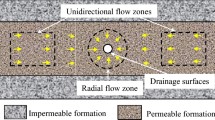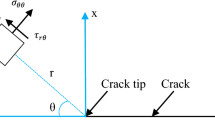Abstract
According to the stress state of the crack surface, crack rock mass can be divided into complex composite tensile-shear fracture and composite compression-shear fracture from the perspective of fracture mechanics. By studying the hydraulic fracturing effect of groundwater on rock fracture, the tangential friction force equation of hydrodynamic pressure to rock fracture is deduced. The hydraulic fracturing of hydrostatic and hydrodynamic pressure to rock fracture is investigated to derive the equation of critical pressure when the hydraulic fracturing effect occurs in the rock fracture. Then, the crack angle that is most prone to hydraulic fracturing is determined. The relationships between crack direction and both lateral pressure coefficient and friction angle of the fracture surface are analyzed. Results show that considering the joint effect of hydrodynamic and hydrostatic pressure, the critical pressure does not vary with the direction of the crack when the surrounding rock stationary lateral pressure coefficient is equal to 1.0. Under composite tensile-shear fracture, the crack parallel to the direction of the main stress is the most prone to hydraulic fracturing. Under compression-shear fracture, the hydrodynamic pressure resulting in the most dangerous crack angle varies at different lateral pressure coefficients; this pressure decreases when the friction angle of the fracture surface increases. By referring to the subway tunnel collapse case, the impact of fractured rock mass hydraulic fracturing generated by hydrostatic and hydrodynamic pressure joint action is calculated and analyzed.
Similar content being viewed by others
References
JULIAN B R, FOULGER G R, MONASTERO F C, BJORNSTAD S. Imaging hydraulic fractures in a geothermal reservoir [J]. Geophysical Research Letters, 2010, 37(7): 1–5.
YANG Xiao-li, QIN Chang-bing. Limit analysis of supporting pressure in tunnels with regard to surface settlement [J]. Journal of Central South University, 2015, 22(1): 303–309.
YANG Xiao-li, LONG Ze-xiang. Roof collapse of shallow tunnels with limit analysis method [J]. Journal of Central South University, 2015, 22(5): 1929–1936.
CHEN Wei-tao, WANG Ming-nian, WEI Long-hai, JI Yan-lei, GAI Zhi-ying, HUANG Ren-de. Analysis of causes and disposals for water gushing of land regions Xiamen of submarine tunnel [J]. Chinese Journal of Geotechnical Engineering, 2008, 30(3): 457–461. (in Chinese)
TANG Xiong-jun, FAN Jian-hai, ZHANG Tao, WANG Yuan-han. Analysis and treatment of the collapse in Erdaoya tunnel [J]. Modern Tunneling Technology, 2007, 44(4): 73–78. (in Chinese)
HUBBERT M K, WILLIS D G. Mechanics of hydraulic fracturing [J]. AIME Petroleum Transactions, 1957, 210: 153–168.
NOBARI E S, LEE K L, DUNCAN J M. Hydraulic fracturing in zoned earth and rockfill darns [R]. Berkley, California: University of California, 1999.
DING Jin-li, SUN Ya-ping. Analysis of stress of thick wail cylinder of compacted soil in hydraulic fracturing experiment [J]. Journal of Hydraulic Engineering, 1987(3): 16–22. (in Chinese)
YANG You-kui, XIAO Chang-fu, QIU Xian-de, WU Gang. Fracture geometry and pressure distribution in fracture for hydro-fracturing [J]. Journal of Chongqing University: Natural Science, 1995, 19(3): 20–26. (in Chinese)
ZHAN Mei-li, CEN Jian. Experimental and analytical study of hydraulic fracturing of cylinder sample [J]. Chinese Journal of Rock Mechanics and Engineering, 2007, 26(61): 1173–1181. (in Chinese)
HUANG Run-qiu, WANG Xian-neng, CHEN Long-sheng. Study on the effect of hydraulic fracturing during water gushing in deep tunnel [J]. Chinese Journal of Rock Mechanics and Engineering, 2000, 19(5): 573–576. (in Chinese)
LI Zong-li, REN Qing-wen. Analysis and discussion on rock and concrete material hydraulic fracturing under natural power [J]. Rock and Soil Mechanics, 2008, 29(8): 2121–2125. (in Chinese)
SHENG Jin-chang, ZHAO Jian, SU Bao-yu. Analysis of hydraulic fracturing in hydraulic tunnels [J]. Chinese Journal of Rock Mechanics and Engineering, 2005, 24(7): 1226–1230. (in Chinese)
FRALDI M, GUARRACINO F. Limit analysis of collapse mechanisms in cavities and tunnels according to the Hoek-Brown failure criterion [J]. International Journal of Rock Mechanics and Mining Sciences, 2009, 46(4): 665–673.
FRALDI M, GUARRACINO F. Evaluation of impending collapse in circular tunnels by analytical and numerical approaches [J]. Tunneling and Underground Space Technology, 2011, 26(4): 507–516.
FRALDI M, GUARRACINO F. Analytical solutions for collapse mechanisms in tunnels with arbitrary cross sections [J]. International Journal of Solids and Structures, 2010, 47(2): 216–223.
YANG X L, HUANG F. Collapse mechanism of shallow tunnel based on nonlinear Hoek-Brown failure criterion [J]. Tunneling and Underground Space Technology, 2011, 26(6): 686–691.
YANG X L, YAN R M. Collapse mechanism for deep tunnel subjected to seepage force in layered soils [J]. Geomechanics and Engineering, 2015, 8(5): 741–756.
YANG X L. Upper bound limit analysis of active earth pressure with different fracture surface and nonlinear yield criterion [J]. Theoretical and Applied Fracture Mechanics, 2007, 47(1): 46–56.
YANG X L, QIN C B. Limit analysis of rectangular cavity subjected to seepage forces based on Hoek-Brown failure criterion [J]. Geomechanics and Engineering, 2014, 6(5): 503–515.
KAWAMOTO T, ICHIKAWA Y, KYOYA T. Deformation and fracturing behaviour of discontinuous rock mass and damage mechanics theory [J]. International Journal for Numerical & Analytical Methods in Geomechanics, 1988, 12(4): 321–327.
EVEET J B, LIU C. Fundamentals of fluid mechanics [M]. New York: McGraw-Hill, 1997: 381–390.
Author information
Authors and Affiliations
Corresponding author
Additional information
Foundation item: Project(50908234) supported by the National Natural Science Foundation of China; Project(2011CB710604) supported by the Basic Research Program of China
Rights and permissions
About this article
Cite this article
Zhou, Z., Yang, H., Wang, Xc. et al. Fractured rock mass hydraulic fracturing under hydrodynamic and hydrostatic pressure joint action. J. Cent. South Univ. 23, 2695–2704 (2016). https://doi.org/10.1007/s11771-016-3331-6
Received:
Accepted:
Published:
Issue Date:
DOI: https://doi.org/10.1007/s11771-016-3331-6




